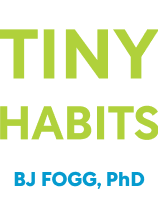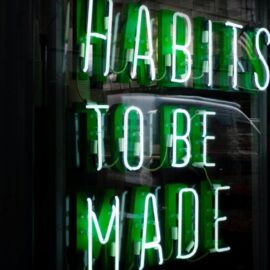

This article is an excerpt from the Shortform book guide to "Tiny Habits" by BJ Fogg. Shortform has the world's best summaries and analyses of books you should be reading.
Like this article? Sign up for a free trial here .
Are you interested in BJ Fogg’s Tiny Habits method but aren’t quite sure how to use apply it in real life? Do you want Tiny Habits examples to help you better understand?
In this article, we’ve put together six examples of how to use the Tiny Habits method. One of the examples is from Fogg himself and the other five are from Habiteers (anyone who follows the Tiny Habits method).
Continue on for Tiny Habits examples.
Tiny Habits Examples
In Tiny Habits, Stanford behavioral scientist BJ Fogg argues that the best way to change behavior is to start small. Fogg encourages us to drop any moral judgment about “good” and “bad” habits and view our behavior scientifically, using specific behavior design skills to engineer lasting changes. This article contains six Tiny Habits examples showing different ways that the method can be used.
Example: The Maui Habit
Fogg invented this habit in Maui and has taught it to thousands of people at his boot camps. It’s a good way to start the day on a positive note.
Recipe:
* After my feet touch the floor in the morning,
* I will say, “It’s going to be a great day,” while feeling confident and optimistic.
* To celebrate, I will smile.
Try incorporating this habit into your morning routine. Experiment with the recipe that works best for you.
You can change the anchor: “When I open my eyes…” or “When I look in the mirror…”
Adapt the habit to your circumstances. You don’t want this to feel fake. So if you know you have a challenging day ahead, you can use uncertain intonation and say, “Well, something great is going to happen today…”
Example: Rachel and Managing ADHD
Amy acted as Ringleader in designing changes for her daughter Rachel. Rachel, in fourth grade at the time, had been diagnosed with ADHD and was beginning to fall behind in school. Rachel was very intelligent, but she had difficulties with time management and getting herself to concentrate.
Amy decided to use Tiny Habits to try and get Rachel back on track. First, she talked to Rachel about her aspirations. While Rachel didn’t care about getting good grades or pleasing the teacher, she did care when Amy said that she might have to repeat fourth grade. Amy put the outcome “Keeping up with my friends at school” in a circle, and together they brainstormed a Swarm of Behaviors. They created some Tiny Habit recipes to integrate homework into Rachel’s afternoon routine, being sure to celebrate immediately with trampoline jumping, stickers, and exuberant dances each time Rachel completed the habit. One especially effective time management habit was as follows: After I hang up my backpack, I will see what homework I have and write down an estimate of how much time it will take. Over time and through discussions with Amy, Rachel became more accurate at estimating her homework time, and this Tiny Habit became something she executed by herself.
The skills that Rachel gained using this habit as a starting point led to her coming out of special education into mainstream classes, eventually taking advanced placement classes and graduating with honors.
Example: Mike, Chris, and the Coffee Filter
Mike acted as a Ninja for his 21-year-old son Chris. Chris had been a smart kid, but at 21 he was still living with his parents, and he couldn’t get on top of basic life skills like paying his bills and tidying up. He didn’t make an effort to get on with Mike, his mother Carla (Mike’s wife), or his little brother. The friction between Chris and the other family members made for a tense atmosphere at home and began to affect the relationship between Mike and Carla.
Mike attended one of Fogg’s Behavior Change Boot Camps for work purposes, but he soon realized that he could apply the techniques to help Chris. Starting with Chris’s failure to clean the coffee filter after use, which was a constant problem between them, Mike switched his focus from trying to motivate Chris to work with the Ability and Prompt dimensions. He broke down the process of cleaning the coffee filter into three parts: taking out the filter, rinsing it, and putting it back.
First, Mike asked Chris to take the filter out and leave it on the counter. Chris did this and Mike thanked him sincerely. After a few weeks, he asked Chris to start rinsing the filter after he had taken it out. The next time Mike went into the kitchen, he didn’t see the filter on the bench and thought Chris must have reverted to his old habits. Then he looked inside the coffee maker and saw that Chris had completed the third step, putting back the filter, without being asked.
The progress here and the good feelings it evoked helped Chris to develop more Tiny Habits. This vastly improved the family dynamic, and the approach helped Chris to start getting on top of some of his other problems.
Example: Katie’s Social Media Habit
We can see the Action Line at work in the situation of Katie, a successful executive. Katie had one troublesome habit that consistently fell above the Action Line: scrolling through social media on her phone after her alarm went off at 4:30 am, not leaving her enough time to go to the gym.
To conquer this social media habit, Katie examined M, A, and P in turn.
* Her motivation was to stay in touch with family and friends. Knowing that this motivation would be hard to change, she moved on to Ability.
* Scrolling through social media in bed is incredibly easy, so there were opportunities here to make it harder. Katie experimented with several options, eventually finding that keeping her phone in the kitchen overnight made the behavior hard enough that she wasn’t tempted.
* As the prompt for this behavior was the phone itself, putting the phone in the kitchen also removed the prompt. Katie bought an alarm clock for her bedroom, which woke her up without the temptation of social media.
After this adjustment, Katie successfully banished the bad habit and started going to the gym immediately after she woke up.
Example: Sarika and the Stovetop Burner
One person who manipulated Ability with great success was Sarika, a project manager in Bangalore. Though successful at work, Sarika had a lot going on behind the scenes: She had bipolar disorder, and she was trying to come off her medication and manage the symptoms with a combination of healthy eating, exercise, therapy, and meditation. Developing and maintaining a routine was especially important, because any variations in the routine would act as early warning signs for episodes of mania or depression.
Unfortunately, Sarika found routine extremely difficult. The only thing that worked was to create little toeholds via the Tiny Habits method.
* She introduced the habit of turning the stove burner on when she went into the kitchen in the morning.
* She introduced the habit of putting her meditation cushion in the middle of the room, sitting on it, and taking three breaths.
* She introduced the habit of putting out her yoga mat and stretching for thirty seconds.
These Tiny Habits grew into cooking herself breakfast, meditating consistently, and exercising. On days when she reverted to only turning on the burner or only doing thirty seconds of stretching, she didn’t beat up on herself—she celebrated because she had kept her habit alive. In time, Sarika noticed that practicing Tiny Habits had made her more emotionally resilient, probably because of the non-judgmental attitude toward stumbles and challenges.
Example: The Celebration Blitz
The Celebration Blitz is an ideal technique if you want to feel better quickly. It’s also a great way to practice your celebration skills.
To do a Celebration Blitz:
- Go to the messiest place in your house or office.
- Set a timer for three minutes.
- Start tidying up. For every single thing you put away, celebrate. Use a variety of celebrations—anything that makes you feel successful. Clench your fists, cheer, do a victory dance, say “Wow, that looks great!”
- When the timer goes off, stop tidying. How do you feel?
Everyone who tries this finds that they feel happier, lighter, and more successful than they did three minutes ago.
Linda, Fogg’s sister, used Celebration Blitzes to help her get through a difficult situation. Her husband had advanced Alzheimer’s disease, the family was in deep financial trouble, and she felt overwhelmed most of the time. When she felt things were too much, she let herself cry as much as she needed to—but then she got up and did a Celebration Blitz for three minutes (or five minutes if she was feeling particularly down). This helped her move past her grief and stay positive and emotionally stable for her family.

———End of Preview———
Like what you just read? Read the rest of the world's best book summary and analysis of BJ Fogg's "Tiny Habits" at Shortform .
Here's what you'll find in our full Tiny Habits summary :
- How you can successfully create new habits that stick
- Why you don't need motivation, just science
- Why even flossing one tooth should be considered a victory






